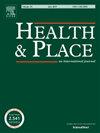墨西哥2型糖尿病的社会驱动因素:城市化和不健康食品支出的空间多层次方法。
IF 4.1
2区 医学
Q1 PUBLIC, ENVIRONMENTAL & OCCUPATIONAL HEALTH
引用次数: 0
摘要
2型糖尿病(T2DM)在世界范围内呈增长趋势,特别是在拉丁美洲国家。这次大流行的决定因素多种多样,并表现出明显的空间差异。此外,疾病报告单位的规模与疾病决定因素的空间分辨率之间往往存在不匹配。本研究考察了2016年和2022年墨西哥各城市2型糖尿病死亡率的社会驱动因素,重点关注与城市化和不健康食品支出相关的变量。我们应用一般线性混合效应模型与空间随机成分来解释状态异质性。我们发现,在这两年中,一些与城市化相关的变量与2型糖尿病死亡率显著相关,如每1000名居民的城市土地利用面积、基本住房服务的获得情况和从事非正式活动的人口。直到2022年,不健康食品获取的影响才变得显著,与空间依赖性的增加相一致,表明城市和饮食风险因素的地理扩散范围更广。两种模型的边际和条件r平方值均具有较高的解释力(2016年边际为0.811,2022年为0.808;条件r平方值分别为0.834和0.832),大部分方差被固定效应解释。值得注意的是,在研究期间,2型糖尿病的平均死亡率增加了26%。这种方法增强了我们对结构和空间因素如何相互作用以形成健康结果的理解,突出了快速城市化地区有针对性的公共卫生战略的必要性,并强调了城市条件和食物环境对健康的多因素影响,特别是在指导饮食干预以减轻2型糖尿病方面。本文章由计算机程序翻译,如有差异,请以英文原文为准。
Social drivers of type 2 diabetes in Mexico: A spatial multilevel approach to urbanization and unhealthy food expenditure
Type 2 diabetes mellitus (T2DM) is growing worldwide, particularly in Latin American countries. The determinants of this pandemic are diverse and exhibit distinctive spatial variations. Moreover, there is often a mismatch between the scale of disease reporting units and the spatial resolution of disease determinants. This study examines the social drivers of T2DM mortality in Mexican municipalities for 2016 and 2022, focusing on variables related to urbanization and expenditure on unhealthy food. We applied general linear mixed-effects models with a spatial random component to account for state heterogeneity. We found that some urbanization-related variables were significantly associated with T2DM mortality in both years, such as urban land use area per 1000 inhabitants, access to basic housing services, and population employed in informal activities. The effect of unhealthy food access became significant only in 2022, coinciding with an increase in spatial dependence, suggesting a broader geographic diffusion of urban and dietary risk factors. The marginal and conditional R-squared values indicate high explanatory power in both models (marginal: 0.811 in 2016 and 0.808 in 2022; and conditional: 0.834 and 0.832, respectively), with most variance explained by the fixed effects. Notably, the mean mortality rate for T2DM increased by 26 % during the study period. This approach enhances our understanding of how structural and spatial factors interact to shape health outcomes, highlighting the need for targeted public health strategies in rapidly urbanizing regions and emphasizing the multifactorial impact of urban conditions and food environments on health, particularly in guiding dietary interventions to mitigate T2DM.
求助全文
通过发布文献求助,成功后即可免费获取论文全文。
去求助
来源期刊

Health & Place
PUBLIC, ENVIRONMENTAL & OCCUPATIONAL HEALTH-
CiteScore
7.70
自引率
6.20%
发文量
176
审稿时长
29 days
期刊介绍:
he journal is an interdisciplinary journal dedicated to the study of all aspects of health and health care in which place or location matters.
 求助内容:
求助内容: 应助结果提醒方式:
应助结果提醒方式:


